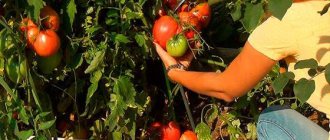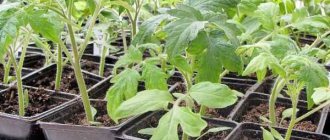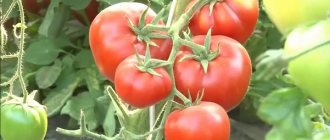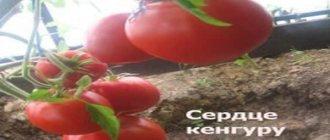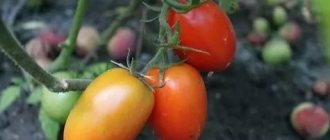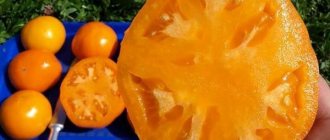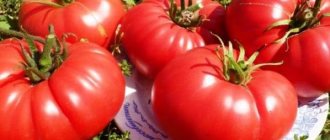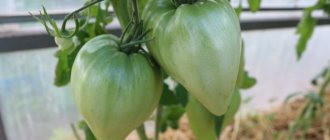Growing
Under favorable weather conditions, tomatoes can begin to be planted as early as April. But experienced gardeners recommend playing it safe and planting seedlings in May (the average daily temperature does not fall below +15 degrees).
The most common and convenient scheme is where:
- the distance between rows is at least 50 cm;
- between holes - at least 40 cm;
- passage between rows - 90 cm.
This will ensure free growth and development of the bushes. Make the process of watering and processing tomatoes easier for yourself.
Variety care
It can be divided into the stage before and after transplantation into the ground.
Before or before planting in the ground, pay close attention to the seedlings. If they turn yellow, it means they don't have enough calcium.
Make an ash solution: 1 cup of ash per 10 liters of water and pour the tomatoes directly to the root. If it is not possible to find ash, purchase ready-made potash fertilizers for tomatoes, for example, monopotassium phosphate. To use it you need to: spread it over the surface of the earth, but no closer than 8 cm from the stem and loosen it thoroughly. Do this procedure better in the morning
If they turn yellow, it means they lack calcium. Make an ash solution: 1 cup of ash per 10 liters of water and pour the tomatoes directly to the root. If it is not possible to find ash, purchase ready-made potash fertilizers for tomatoes, for example, monopotassium phosphate. To use it you need to: spread it over the surface of the earth, but no closer than 8 cm from the stem and loosen it thoroughly. Do this procedure better in the morning.
If after hardening the leaves turn brown or purple, they lack phosphorus or the hardening began too quickly. If, after being placed in the house, the leaves do not change color, then this is definitely a lack of phosphorus. To eliminate it you need to: feed the seedlings with superphosphate. Don't forget about watering, which was mentioned above.
Care after transplanting into the ground is to:
- tie it up in a timely manner: despite the fact that the bushes are miniature, due to the heaviness of the tomatoes, they can break off - only in this case is support necessary.
- feed for 7 days after transplantation, during the period of bud formation and fruit ripening.
- install protection against sudden temperature changes from a plastic 5-liter bottle (cut small windows on both sides of it - they will allow air to circulate).
- Water in a timely manner, and strictly at the root. Leaves should not be touched as this can lead to the development of fungal diseases.
- loosen the soil after watering.
Read also: Buy mushrooms for planting
Care in a greenhouse is similar, but there is no need to install bottle protection. It is enough to ventilate the greenhouse and check the temperature once a day.
The ideal complex fertilizer is nitroammophoska.
Resistance to diseases and adverse conditions
The Pink Angel variety is resistant to many nightshade diseases and even late blight. The fruits have time to ripen before its development.
But this variety often suffers from caterpillars. Active time is late evening and night. They do not pay attention to ripe or ripening fruits, but those bushes that have just begun to form are especially interesting to them. In a few hours they can spoil the entire seedling.
Advantages of the variety
Tomato is rich in vitamins such as B6 - pyridoxine, A or beta-carotene, B1 - thiamine.
Description of the tomato variety Burning Heart, characteristics and cultivation
Raspberry tomatoes are loved by gardeners. Tomato Burning Heart gives juicy, delicious berries. Summer residents are eager to add new items to their collections. It is possible to get your own seeds.
What attracts the variety
Gardeners in problem regions dream of pink salad tomatoes. They are attracted by the sweet taste and juicy pulp. But growing and getting a decent harvest is not easy. Varieties and hybrids are capricious.
Altai breeders gave summer residents an unpretentious tomato. Description of the variety:
- designed for open ground and temporary (film) shelters;
- average ripening period (from germination to harvest sampling - 100 days);
- indeterminate plant (height reaches 1 m 80 cm);
- 6 clusters are formed on the main stem;
- leaves are dark green.
Compliance with the rules of agricultural technology allows you to get 6.4 kg/sq. m of delicious fruits. The plant requires staking and shaping. The Burning Heart is included in the State Register of the Russian Federation. Recommended for growing in private plots and personal gardens.
What berries are summer residents proud of?
The description of the variety promises to provide the family with tasty fruits throughout the season. Raspberry berries are good on the table in slices and salads. The juices have an unexpected, bright hue.
Tomatoes grown outside are tastier and more aromatic than greenhouse tomatoes. Gardeners are pleased with the following characteristics of the Flaming Heart:
- pink-raspberry color;
- heart shape;
- weight up to 240 g;
- juicy, fleshy pulp;
- thick skin;
- sweet, dessert taste;
- weak ribbing of the fruit.
It is possible to collect 2-3 kg of fleshy berries from a bush. Gardeners note the transportability of the Flaming Heart. Tomatoes remain marketable during transportation.
The berries of the first harvest weigh 220-240 g. Then they become noticeably smaller. Gardeners have found the use of non-standard products: they roll whole products into jars, make pastes and juices. The fiery assortment is tasty and healthy: tomatoes contain lycopene, ascorbic acid, and sugars.
How to get a good harvest
Growing indeterminate tomatoes has its own peculiarities. Reviews from experienced gardeners will help you recognize them. Proper application of the advice of agronomists will provide seven tomatoes for the whole summer. The following should be remembered:
- seeds from reputable producers are ready for sowing: no stimulation required;
- your own material should be checked for germination and disinfected;
- seedlings need to be taken care of 50-60 days before the intended planting in a permanent place;
- plants dive when they grow 2 true leaves;
- seedlings are illuminated, hardened, fed;
- the beds are prepared in advance (mature compost is laid in the fall, a mineral complex is laid in the spring);
- the use of calcium nitrate will strengthen plants and increase productivity;
- tomatoes should be shaded 3-4 days after planting on the ridges;
- plants need moderate watering;
- Ripe fruits should be collected regularly (the bush will give strength to those that ripen).
The flaming heart requires the formation of 2 stems. It is recommended to lighten the plant until the brush becomes full. A garter to the support is required.
What did the gardeners decide?
Reviews from gardeners are favorable. Burning Heart is a productive variety. The fruits are beautiful and tasty. Purpose: from salad to canning. Berries do not lose marketability during transportation.
Gardeners are disappointed by the low shelf life (a week in the refrigerator). Large bushes are difficult to cover with film during cold weather. But the advantages outweigh the disadvantages. The flaming heart has earned the love of gardeners.
dachamechty.ru
Tomato flaming heart description – Summer resident’s guide
The description of the variety promises to provide the family with tasty fruits throughout the season. Raspberry berries are good on the table in slices and salads. The juices have an unexpected, bright hue.
Tomatoes grown outside are tastier and more aromatic than greenhouse tomatoes. Gardeners are pleased with the following characteristics of the Flaming Heart:
- pink-raspberry color;
- heart shape;
- weight up to 240 g;
- juicy, fleshy pulp;
- thick skin;
- sweet, dessert taste;
- weak ribbing of the fruit.
It is possible to collect 2-3 kg of fleshy berries from a bush. Gardeners note the transportability of the Flaming Heart. Tomatoes remain marketable during transportation.
The berries of the first harvest weigh 220-240 g. Then they become noticeably smaller. Gardeners have found the use of non-standard products: they roll whole products into jars, make pastes and juices. The fiery assortment is tasty and healthy: tomatoes contain lycopene, ascorbic acid, and sugars.
Experienced gardeners love to get acquainted with new varieties of tomatoes. When choosing a variety, not only descriptions from manufacturers are taken into account, but also reviews from gardeners who have already grown new tomatoes. Almost all summer residents speak well of the Loving Heart tomato.
The indeterminate variety Loving Heart grows up to 2 m in a greenhouse; in open ground, powerful bushes form 1.6-1.8 m in height.
The tomato is resistant to adverse weather conditions and diseases. The variety is classified as mid-season. The fruits ripen 90-115 days after seed germination.
An average of 5-6 tassels are tied per bush. 5-7 fruits of the Loving Heart are usually formed in the hand.
The fruits weigh 700-800 g. If you set out to grow a tomato even larger, you need to leave 3-4 ovaries on the cyst. With proper care, a tomato can ripen weighing a kilogram or more. The deep red tomatoes are shaped like a heart.
Loving Heart tomatoes are characterized by thin skin, fleshy pulp, which has a granular structure at the break. The fruits have a rich tomato aroma that does not disappear even after processing.
The delicate, sweetish taste of a tomato with a hint of sourness is a significant advantage of the tomato.
Advantages of tomato:
- expressive taste and persistent aroma;
- high productivity;
- resistance to temperature changes and diseases.
The disadvantages include the poor keeping quality of the fruit, so tomatoes must be eaten or processed immediately after harvesting. Due to the large mass and thin peel, the fruits are poorly stored and practically not transportable. You also need to keep in mind that in the direction from the lower clusters to the upper ones the fruits become smaller.
It is recommended to plant seeds in early to mid-March. For high-quality germination of planting material, it is advisable to carry out some preparatory work.
To disinfect grains, they are treated with a solution of potassium permanganate. To do this, seeds wrapped in cloth are dipped in a pale solution of potassium permanganate for 15-20 minutes and then washed in clean water.
Important! It must be taken into account that a saturated solution of potassium permanganate can burn planting material.
Some gardeners practice hardening tomato seeds.
To do this, seeds of the Loving Heart variety are placed in the refrigerator (on the bottom shelf) for 15-16 hours, then left in the room for 5-6 hours. Alternating temperatures can be done 2 times.
It is believed that such events harden the plants and therefore future seedlings will grow more resistant to low temperatures.
- Make several rows in prepared moist soil. The seeds are placed in the ground and lightly sprinkled with soil (a layer of 1 cm is sufficient). Before emergence, the container is covered with polyethylene and placed in a warm place.
- As soon as the first shoots appear, the covering material is removed. In order for the seedlings to grow strong, it is advisable to provide additional lighting. For this purpose, phytolamps are installed.
- When the seedlings of the Loving Heart grow two leaves, you can plant the sprouts in separate pots. When watering plants, do not allow the soil to become waterlogged, otherwise the tomato roots may rot.
Important! At this stage, you should not allow the tomato stems to stretch excessively. Increased growth of seedlings can be prevented by increasing illumination and lowering the temperature.
One and a half to two weeks before planting tomatoes of the Loving Heart variety, seedlings begin to harden in open ground. To do this, containers are taken outside for a short time. Gradually the hardening period is increased.
Tomato care
You can plant seedlings in open ground after the threat of frost has passed, as soon as the soil warms up to 15˚ C and stable warm weather sets in. More specific dates depend on the climatic characteristics of the region. In the middle zone, the right time is mid-May.
In a row, bushes are placed in increments of 60-70 cm, and a path 80-90 cm wide is left between the rows. It is better to place the beds in a north-south direction. In this case, the tomatoes will be illuminated better and more evenly. When planting Loving Heart tomatoes, pegs are immediately installed and the bushes are carefully tied up.
Tomato bushes of the Loving Heart variety are formed into one or two stems. Stepchildren must be cut off. At the same time, it is important to leave small shoots to prevent the growth of new stepsons from these sinuses. At a height of approximately 1.8 m, the top of the tomato is pinched to stop further growth of the stem.
To form large fruits, you need to remove several ovaries from the flower clusters. It is enough to keep 5-6 brushes with 2-3 ovaries on the bush. When ripening Loving Heart tomatoes, it is important to tie up each cluster so that it does not break off.
READ MORE: Growing cucumbers
Watering and fertilizing
When watering, moderation must be observed. To prevent the soil from drying out, it is recommended to mulch the soil. During fruit set and growth, the volume of watering is increased. At the same time, you must try to prevent water from stagnating.
Advice! Green manure can be used as mulch.
The green mass of mustard will simultaneously protect the soil from drying out, protect the bush from pests and increase soil fertility.
When choosing a fertilizer, you must not allow the plant to direct all its forces to the growth of green mass. Therefore, nitrogen fertilizing is used only at the stage of young seedlings, when they have recently been transplanted into open ground and the plant requires nutrition for growth.
As soon as the ovaries appear on the bushes and fruits begin to form, they move on to superphosphates and potassium chloride. It is best to thoroughly fertilize the area in the fall, when the soil is being prepared for future plantings of tomatoes.
Important! When applying any fertilizers, do not allow the solutions to come into contact with the stems or leaves of tomatoes.
You can spray the bushes with a solution of ash with the addition of boric acid (take 2 liters of ash and 10 g of boric acid per 10 liters of water). This composition not only helps the ovaries to form faster, but also effectively fights pests (black aphids).
Advice! To dilute mineral and organic fertilizers, only warm water is used.
Ripe tomatoes need to be harvested every three to four days. Tomatoes are cut together with the stalk. To store Loving Heart tomatoes, select a dry, ventilated room with a normal humidity level. To keep tomatoes better preserved and not damaged, it is better to place them in boxes covered with paper.
Growing tomatoes doesn't require much time or effort. Simple rules for caring for a tomato of the Loving Heart variety will allow even novice gardeners to get a magnificent harvest.
Reviews from summer residents
Tatyana Izmailova, Tyumen
I grew Loving Heart tomatoes for only one season. I really liked the variety – the fruits were so tasty and large that the family’s harvest was in great demand.
I grew the bushes in a greenhouse and formed them into one stem. I have never collected such large fruits before - the tomatoes on the first bunch weighed an average of 900 grams. The next fruits were already smaller (600-700 gr.
), but it didn't disappoint me.
Tomato care
You can plant seedlings in open ground after the threat of frost has passed, as soon as the soil warms up to +15˚ C and stable warm weather sets in. More specific dates depend on the climatic characteristics of the region. In the middle zone, the right time is mid-May.
In a row, bushes are placed in increments of 60-70 cm, and a path 80-90 cm wide is left between the rows. It is better to place the beds in a north-south direction. In this case, the tomatoes will be illuminated better and more evenly. When planting Loving Heart tomatoes, pegs are immediately installed and the bushes are carefully tied up.
Tomato bushes of the Loving Heart variety are formed into one or two stems. Stepchildren must be cut off
At the same time, it is important to leave small shoots to prevent the growth of new stepsons from these sinuses. At a height of approximately 1.8 m, the top of the tomato is pinched to stop further growth of the stem.
To form large fruits, you need to remove several ovaries from the flower clusters. It is enough to keep 5-6 brushes with 2-3 ovaries on the bush
When ripening Loving Heart tomatoes, it is important to tie up each bunch so that it does not break off
Rules for planting and care
Growth and development depend on proper planting. And compliance with timely care affects the quality and quantity of the harvest. The variety is unpretentious, so it is recommended for beginning gardeners.
To obtain an earlier harvest, Loving Heart tomatoes are grown through seedlings.
Important! The plant is transplanted to a permanent place at the age of 70 days, so the time for sowing seeds depends on climatic conditions.
As a rule, seeds are sown in mid or late March. To obtain strong, healthy seedlings, seeds must undergo pre-sowing treatment. To do this, they are soaked for 20 minutes in a weak solution of potassium permanganate, then washed under running water.
To speed up the emergence of seedlings, the seed is germinated in moist material for about 10-12 hours. In this case, it is necessary to ensure that the cloth is constantly moistened, preventing it from drying out.
In order for seedlings to quickly take root in a new place, many summer residents harden the seeds. To do this, they are placed in the refrigerator for 12-16 hours, then taken out to a warm room for 5-6 hours. This procedure is carried out several times.
Before planting seeds, you need to purchase soil and containers. For planting, a box 10 cm high, disposable and peat cups are suitable. It is better to purchase soil in a store, as it is already filled with the necessary microelements and disinfected.
Planting seeds for seedlings:
- The seeds are buried 1 cm in prepared moist soil and sprinkled with earth.
- For better germination, crops are covered with polyethylene or glass to create a favorable microclimate.
- A week after the emergence of seedlings, the shelter is removed and the container is moved to the brightest place.
- Since there is little sun in spring, the seedlings are given additional light so that they do not stretch out and grow weakened.
- After the first true leaves appear on the plant, the seedlings are planted in separate containers with a volume of at least 0.2 liters.
- After 2 weeks, re-pick into a larger pot, deepening the plant to the cotyledon leaves.
As the plant grows, it is necessary to carry out timely watering with warm water. 14 days before planting in a permanent place, the seedlings are hardened off. To do this, it is taken out into the fresh air, increasing the stay time daily.
Transplanting seedlings
Planting of seedlings in a permanent place is carried out after the soil has warmed to 10 °C. Tomatoes of the Loving Heart variety are planted at the age of 60-70 days. During this time, the plant should develop a powerful root system, have 6-7 leaves and a powerful stem.
READ MORE: Growing tomatoes using Dutch technology, basic rules
For planting in open ground, choose a well-lit area protected from drafts. Good predecessors for tomatoes will be legumes, pumpkin, and cabbage crops.
To plant the plant, make a hole and add 1 tbsp. l. ash and spill with warm water. Seedlings are planted by transshipment at an acute angle. This will help the plant grow an additional root system, thereby increasing productivity.
Advice! Since the Loving Heart tomato is a tall variety, per sq. m. no more than 4 plants are placed.
Characteristics of the tomato variety Honey Heart, its yield
The new work of Siberian breeders - the Honey Heart tomato - will delight lovers of yellow tomatoes. There is no need to wait for summer at all: a compact plant can grow and bear fruit on the loggia in a beautiful flowerpot.
Description of the hybrid Honey Heart
Honeyheart is a first generation hybrid. The bushes are compact in shape, low (maximum height 70 cm, height may be lower). According to the ripening period, the hybrid is included in the group of early tomatoes - Honey Heart enters the time of fruiting at 90 (95) days from germination.
The F1 hybrid shows good performance. More than 8 kg of fruits (8.5 kg/m²) are collected from a unit area (1 m²). In the south, a hybrid of the determinate type grows well in open ground; in temperate climates it is recommended to grow it in a greenhouse or in a container, growing it in one stem.
The characteristics of the composition of the pulp will please lovers of diets and healthy eating. In the summer, the yellow fruits of the Honey Heart will be the main source of beta-carotene. Children love the yellow-orange tomato for its high sugar content in the pulp and sweet taste.
The fruits can be picked from the bush in an unripe form - tomatoes ripen well in boxes and accumulate the required amount of sugars. The fruits are stored for a long time, eaten fresh, and prepared into healthy juice.
The main valuable qualities of the hybrid
Description of the variety, main advantages, disadvantages are summarized in the table.
| Advantages | Flaws |
| High yield declared | Requires high soil fertility |
| Good taste rating | |
| Healthy composition of pulp with a high percentage of beta-carotene and healthy sugars | |
| Immunity to pests and diseases of tomatoes | |
| The bushes are easy to care for, you can do without pinching stepsons and forming a bush |
Features of cultivation
The timing of planting seeds for seedlings is extended due to the early ripening of the variety: tomatoes can be sown from the beginning of March to the first days of April.
Before sowing, the seeds must be treated against diseases and pests with a solution of potassium permanganate, and the soil must be treated with it. When sowing seeds into the substrate, do not plant them deeply. A layer of soil of 1.5 cm is enough. Honey Heart seedlings must be pinched when they reach 5–7 cm and two leaves appear. Seedlings respond well to fertilizing with fertilizers containing magnesium and potassium.
Planting in a permanent place takes place from mid-May to the first ten days of June. The soil needs to be fertilized with organic matter and mineral fertilizers. Adhere to a planting pattern of 40 by 70 cm. In the summer, tomato care is standard. The peculiarity of the variety is that the stepsons do not need to be removed.
Diseases and pests
Pre-sowing seed treatment is often sufficient for the health of tomato bushes. In extreme weather conditions (heat, prolonged bad weather), the bushes are treated with phytosporin or other low-toxic fungicide.
Origin and characteristics of the variety
The variety was bred by agricultural breeders and entered into the State Register in 2003. In addition to the copyright holder company, seeds are sold by such well-known companies as Aelita, Siberian Garden and others. Depending on climatic conditions, plants can be cultivated in open ground or in greenhouses throughout the country.
The characteristics of the Bull's Heart tomato are as follows. The bushes are tall (when grown in a greenhouse - up to 150-200 cm), of a determinate type. The stems are quite thin, the leaves are medium. The first flower cluster is formed above the 8-9 leaf, the next ones - after 1-2 leaves. There are usually no more than 3-4 fruits per cluster. Late ripening variety: the first ripe tomatoes begin to be picked no earlier than 120-125 days after the appearance of full shoots.
Usually no more than 3-4 fruits are tied to a brush
The fruits look very attractive: bright red, large, oval-heart-shaped. The cut flesh is sugary, dense, with a small number of seeds. According to reviews, “Bull's Heart” tomatoes also have excellent taste and aroma. They are distinguished by their special sweetness and classic aftertaste, perfect for fresh consumption and for making juices.
When cut, the tomato pulp is sugary, dense, with a small number of seeds
Summer residents appreciate the tomato for the beauty and wonderful taste of the fruit, but the variety cannot be called problem-free. The difficulties that arise when growing it are due to the following properties:
- rapid growth of green mass. The bushes develop according to the determinant type and, in principle, do not need pinching. But the variety requires active pinching and removal of excess flower clusters. As a rule, plants are formed into 1-2 stems, leaving no more than 4 brushes on each. If this is not done, the fruits will turn out small and not very tasty;
- fragility of stems that need to be tied up;
- lack of natural resistance to diseases. The variety is severely affected by various rots and late blight. The fruits ripen late, and diseases can only be avoided with the help of regular preventive treatments;
- sensitivity to fertilizer application. The size and number of fruits are highly dependent on the nutrient content of the soil. According to gardeners, in order to get a decent harvest, it is necessary to feed the plants at least 6-7 times per season;
- heterogeneity of fruits in shape and weight. Classic heart-shaped tomatoes weighing 230-250 g (sometimes up to 400-500 g) ripen only in the lower part of the bush. It often happens that there are only 1-2 such fruits on each plant. Tomatoes that are poured on the top clusters are oval in shape and weigh no more than 100 g;
- low indicators of keeping quality and transportability of fruits;
- rather modest yield. According to official data from the manufacturer, even with proper agricultural technology, a maximum of 4 kg of tomatoes can be harvested per square meter of plantings.
Cultivating the variety is quite difficult. Plants require serious care, and even experienced gardeners’ harvests often leave much to be desired. If you still want to try to grow them, do not be tempted by offers from random sellers, but give preference to seeds of an officially registered variety produced by one of the well-known agricultural companies.
Classic heart-shaped tomatoes ripen only in the lower part of the bush. It often happens that there are only 1-2 such fruits on each plant. Tomatoes that are poured on the top clusters are oval in shape and weigh no more than 100 g
Bush care
Basic care recommendations:
- Carry out moderate but regular watering at the root using warm water;
- Weeds are destroyed in a timely manner;
- The formation of a bush is carried out in 2-3 stems, removing all excess stepsons;
- To prevent branches from breaking off, the bushes are equipped with supports to which they are tied as they grow;
- The first feeding is carried out two weeks after transplantation with superphosphate and potassium chloride. The second - during the formation of ovaries, with a liquid composition of superphosphate and potassium nitrate. The third and fourth - during the fruiting period, using a similar composition as for the second feeding;
- The soil must be mulched with bark, hay, mown dried grass, and sawdust;
- For preventive purposes, bushes are sprayed with special preparations to protect tomato seedlings from insect pests and various diseases.
What did the gardeners decide?
Reviews from gardeners are favorable. Burning Heart is a productive variety. The fruits are beautiful and tasty. Purpose: from salad to canning. Berries do not lose marketability during transportation.
Gardeners are disappointed by the low shelf life (a week in the refrigerator). Large bushes are difficult to cover with film during cold weather. But the advantages outweigh the disadvantages. The flaming heart has earned the love of gardeners.
Tomato Generosity - description and characteristics of the variety
Domestic gardeners and vegetable gardeners often prefer to grow low-growing tomato varieties. Generosity is distinguished by the fact that it is excellent for growing in open ground and does not require care. The fruits are suitable for slicing and salads, as well as for all types of processing. Ripening occurs early, 90 days after the appearance of sprouts. The variety attracts gardeners due to its stable immunity to most diseases to which representatives of the nightshade family are exposed.
Description of the variety
The height of the bushes reaches 50 cm. The leaves are medium in size, rich green in color. The fruits begin to set above the 7th leaf, repeating the ovaries after 1 leaf. One bush produces 4 brushes. If you follow the rules of agricultural cultivation, you can harvest 8 kg of ripe tomatoes from one square meter.
Early ripening helps to avoid late blight infection. The shape of the fruit is round, there is no spot on the stalk. The skin is dense and does not crack during heat treatment. When ripe it acquires a bright red color.
The average weight of one tomato is 80 grams. The taste is sour, the aroma is rich. In a horizontal section, one can observe the presence of 6 seed nests. The taste of the fruit depends on weather conditions. In cool and rainy summers, tomatoes have a more sour taste.
Growing rules
The soil for planting can be prepared in the fall. Humus must be added to the area where tomatoes will be grown. If the soil has not been fertilized since the fall, then complex fertilizers must be added before planting. The nutritional mixture must contain potassium and phosphorus. A distance of 40 cm should be left between the seedlings. For several days after planting, the bushes should be shaded from the rays of the sun. Low-growing bushes do not need tying or pinching. In order to get the highest possible yield, you must adhere to the rules for caring for the variety.
Advantages and disadvantages of the variety
Like all varietal vegetable crops, the Oxheart tomato has its pros and cons.
The advantages include:
large fruit; attractive appearance of the fruit; excellent taste; high yield (with proper care and suitable growing conditions); suitable for cultivation both in open ground and in greenhouses; good resistance to various diseases (which is very important for late-ripening varieties).
Flaws:
- the plant is highly demanding in care;
- long ripening period (which is not suitable for all regions);
- low resistance to temperature changes;
- short shelf life of ripe fruits.
Gardeners' opinion
The Burning Heart tomato has become one of the favorite varieties of gardeners. Summer residents note:
- High yield.
- Attractive appearance of the fruit.
- Good taste.
- The fruits tolerate transportation well without losing their presentation.
- Retains good taste when canned.
However, the low keeping quality of the fruit upsets most gardeners. Tomatoes can be stored in the refrigerator for no more than 7 days, which leads to the need to quickly consume or process the resulting crop.
Tomatoes Burning Heart can be found in many summer cottages. Despite minor shortcomings, the variety is in great demand, which increases every year.
tomato Parodist - description and characteristics of the variety
Inseparable Hearts - a variety of Tomato plant
Information on admission of Tomato Inseparable Hearts from the Register of the State Variety Commission of the Russian Federation
Application for admission No. 74059, registered 2017-11-28. The Tomato variety Inseparable Hearts is included in the register of those admitted in 2021. Approved for use in regions: All regions.
The originator of the Tomato variety Inseparable Hearts is:
LLC `AGROFIRMA AELITA` (129343, MOSCOW, NANSEN TRADE, 1)
Information about the patent for the Tomato variety Inseparable Hearts
Patent holder of the variety Inseparable Hearts:
LLC `AGROFIRMA AELITA` (129343, MOSCOW, NANSEN TRADE, 1)
Application for protection of the variety Inseparable Hearts No. 74060, registered 2017-11-28.
Patent No. 10420, registered 2019-06-11. Estimated patent expiration date 2049-12-31.
Authors of the Tomato variety Inseparable Hearts
- Kachainik Vladimir Georgievich
- Gulkin Mikhail Nikolaevich
- Karmanova Olga Alekseevna
- Matyunina Svetlana Vladimirovna
Other varieties of tomato plant
Add new comment
Register or Login so you don't have to enter your Name and Email every time
Thanks for the comment! It will be published after checking by a moderator!
No comments yet, be the first!
A portal for those who love their dacha
Thanks for your question!
Your question has been sent for moderation. Don't worry, we quickly check your questions and your question will be answered within 1 day.
We have noticed that you are already registered on our website. We recommend that you log in to view the created question.
If you don't remember your password, you can recover it.
You were not registered until today, so we have registered you. Your password has been sent to your specified mailbox.
Help our site develop!
Please read this message, it will not take up much of your time!
We so need your comments and questions to understand in which direction we should develop.
Don't forget to leave a comment if you found what you were looking for. And if you haven’t found it, use the “Ask an Expert” form in the site header. We will answer this question, and other visitors will be able to find the information that you could not find.
Thanks for your question!
Your question has been sent for moderation. Don't worry, we quickly check your questions and your question will be answered within 1 day.
We have noticed that you are already registered on our website. We recommend that you log in to view the created question.
If you don't remember your password, you can recover it.
You were not registered until today, so we have registered you. Your password has been sent to your specified mailbox.
Tomato Honey Heart f1: characteristics and description of a hybrid variety with photos
Productivity of the variety
We recommend reading our other articles
Autoclave Belarus Lux
Description of the gooseberry variety Malachite
Drinking bowl for bees
The best early varieties of sweet peppers
The yield of Honey tomato is on average up to 15 kg of fruit from each square of plantings. But, if the plants are not fed or watered properly, it will drop to 8-10 kg. On average, up to 3.5 kg of tomatoes are harvested from one bush per year.
The taste of a tomato is mainly determined by elements such as boron, magnesium, molybdenum, calcium and sulfur. If the fruits have enough of them, the taste will be rich and sweetish.
The harvest is suitable for making juice and sauce. The fruits make delicious summer salads and fresh snacks.
The fruits have a rich, honeyed taste and bright aroma. They weigh 120–150 g. They contain a large amount of sugars and beta-carotene. These tomatoes can be used to create a diet.
Each tomato has a beautiful orange-yellow color. Heart-shaped with a flat base and a slightly pointed tip. Tomatoes are resistant to cracking and tolerate transportation well. They ripen at home without losing their flavor and aroma characteristics.
Honey tomato fruits grow weighing 300-400 g. The taste is sweetish with a honey aftertaste.
Sweet tomatoes can only grow if they get plenty of sunlight.
Therefore, it is necessary to plant plants not densely, but it is important to remove all excess stepsons and leaves in time
The fruits are round, flattened at the top and bottom. The variety is characterized by large ribbing. After full ripening, the peel acquires a bright pink color. The fruits grow weighing 300-400 g. The pulp is multi-chambered, fleshy, with a lot of juice. Not a lot of seeds. The taste is sweetish, with a honey aftertaste, which is where the name comes from.
The Honey variety tomato is in great demand among gardeners. It is not difficult to grow and the fruits are very tasty.
- Lyudmila Gribko: “Although the variety is called Honey, my harvest was not distinguished by its sweetness, but perhaps it’s due to the lack of sun, I don’t know. Caring for the bushes was not difficult. I treated it a couple of times with fungicides and carried out regular fertilizing with minerals. The tomatoes grew large and rich in color. Just what you need for salads. And yet it’s a pity, they are not as sweet as I would like, I expected more!”
- Andrey Koroza: “Not a bad variety. The tomatoes grow beautifully, the flesh is almost red, very juicy. Almost the entire harvest was processed into juice. The family is very happy. Plants are not demanding in terms of care. Even if I forgot to water, they grew without problems. The fruits turned out sweet, very tasty, at least sell them! Next year they will definitely plant them again.”
- Tatyana Davydova: “I used to always grow these tomatoes in open ground. This time I tried to make them in a greenhouse - it turned out that it was even easier to grow this way. The harvest was 1.5 times more. The fruits are very sweet, rich in color, half were sold, the other was put into canning. I’m very pleased with the variety; now they will grow it every year in greenhouses!”
Advantages and disadvantages
The new variety, thanks to its positive characteristics, has already won the love of gardeners. Advantages of a hybrid:
- The tomato is adapted to growing in cool regions.
- The tomato bears fruit early. Already in early July, the first fruits are tasted.
- Resistance of bushes to nightshade diseases.
- There are a lot of tomatoes growing on the powerful stems.
- The tomatoes are large and fleshy.
- Significant yield indicators. The bush brings up to 4.5 kg per season.
- The tomato has an appetizing appearance and can be transported without any problems.
- The fruits contain a large number of substances beneficial to humans.
Tomato has no obvious disadvantages.
